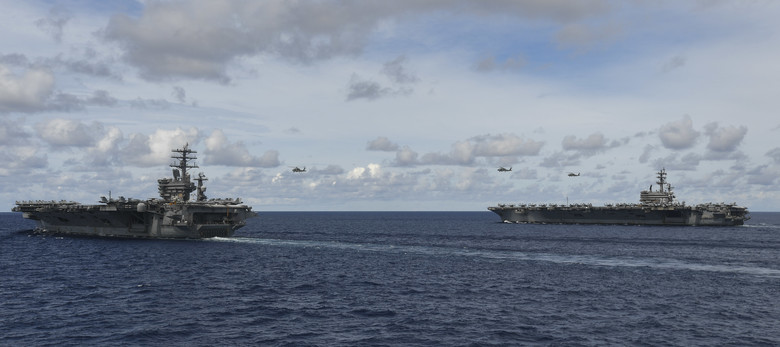
U.S. Navy file photo of the aircraft carriers USS Nimitz (CVN 68) and USS Ronald Reagan (CVN 76). (Photo by Petty Officer 3rd Class Anthony Collier)
The USS Nimitz and USS Ronald Reagan strike groups are conducting military drills in the South China Sea, the first time in the past few years. The Pentagon said the exercise was “a symbol of resolve.”
Forecasting the future of the South China Sea earlier this year, I predicted that 2020 would be a turning point in the South China Sea, from stability to turbulence. What has happened in recent months indicates that this judgment was not built on sand. A review of a series of events in the sea and other areas since May reveals some disturbing changes.
This observation was borne out again by a statement made by U.S. Secretary of State Michael Pompeo on July 13 regarding the U.S. position on maritime claims in the South China Sea. This statement reflects the sharp shift in the U.S. position since the 1990s on not taking sides on territorial disputes in the region.
So-called militarization
The U.S. has been hit hard by COVID-19 and the U.S. military is no exception. Rather than slowing its pace, however, the U.S. is stepping up efforts to leverage the South China Sea issue to contain China.
In an official White House paper — United States Strategic Approach to the People’s Republic of China — which was made public on May 20, the U.S. claimed it would “increase public pressure” on China, push back on its “hegemonic assertions” and provide security assistance to help regional allies and partners build up the capacity to withstand Beijing.
On June 1, the U.S Ambassador to the United Nations submitted a diplomatic note laying out U.S. opposition to China’s claims of “historical rights” in the South China Sea beyond those consistent with the United Nations Convention on the Law of the Sea. Its objections include China’s claim of maritime entitlement derived from treating island groups in the South China Sea as a collective, and the dispersed islands and other features over which China asserts sovereignty using straight or archipelagic baselines.
It is interesting to note, on the same day, that the Philippine government decided to suspend its termination of the Visiting Forces Agreement. On June 9, the Philippine defense secretary, Delfin Lorenzana, visited Zhongye (Thitu) Island in the South China Sea.
The USS Nimitz and Ronald Reagan carrier strike groups conducted dual carrier operations in the Philippine Sea on June 28 to demonstrate their large-scale operational capacity. This came just a week after the first dual carrier operations of the USS Nimitz and USS Theodore Roosevelt on June 21 in the same waters.
When it comes to China’s military drills around the Xisha Islands, the U.S., the Philippines and Vietnam all point the fingers at China at virtually the same time and with the same tone. The U.S. State Department accused China of further destabilizing the situation by conducting military activities in “contested waters and territory” and violating its commitments under the 2002 Declaration on the Conduct of Parties in the South China Sea. The Vietnamese Ministry of Foreign Affairs claimed that China’s military exercises were a violation of sovereignty that could be “detrimental” to Beijing’s relationship with the Association of Southeast Asian Nations and affect peace and stability in the region. The Philippine defense secretary said China’s military exercises near the Xisha Islands were “very concerning” and “highly provocative.”
The U.S. has spared no effort to conduct surveillance and collect intelligence about the Chinese military from the sea and air. The littoral combat ship USS Gabrielle Giffords conducted operations in the South China Sea on June 30 and July 1. The next day, a U.S. Navy EP-3E reconnaissance plane appeared over the Bashi Channel on 8 a.m., then turned west and flew toward the South China Sea for nearly an hour before it returned by the same route. Taking into account the five so-called U.S. freedom of navigation operations (FONOPs) targeted at China in the South China Sea this year, one can easily conclude that the U.S., more aggressive and provocative than ever in its military operations in the South China Sea, is the greatest threat to peace and stability of the region and the biggest “black hand” in militarizing the area.
Click here to read the latest China-US Focus Digest
Collusion with the U.S.?
The U.S. is neither a littoral state nor a claimant of sovereignty in the South China Sea. It surely needs collusion with some countries in the region to maintain its military presence, intervene in disputes and leverage the issue to contain China.
Some countries in the region — either instigated or backed by the U.S. — are taking provocative and reckless actions against China. They justify this by the “lawfare” of diplomatic notes since Malaysia made a submission to the UN Commission on the Limits of the Continental Shelf (CLCS) at the end of last year claiming an extended continental shelf in the South China Sea. Unilateral actions by other claimant states are also at play. The U.S. can even be found behind the scenes in the Code of Conduct negotiations between China and ASEAN countries.
Based on the ruling in the arbitration on the South China Sea initiated by the Philippines, the diplomatic notes submitted by the Philippines, Vietnam and Indonesia against Malaysia and China deny China’s historical rights in the South China Sea, the legal status of Nansha Islands and China’s claim to maritime jurisdiction.
At this critical moment in the diplomatic war of words, the U.S. poked its nose in by submitting to the UN a diplomatic note with objections to all of China’s claimed rights in the South China Sea.
Vietnam conducted oil and gas exploration and exploitation activities in Wan’an Tan last year; its fishing vessel rammed a Chinese Coast Guard ship during an illegal fishing episode in waters off China’s Xisha Islands; and its authorities threatened to lodge a new arbitration case over the South China Sea against China.
Without the U.S. backing, Vietnam would certainly not have the guts or capacity to challenge China. Likewise, Malaysia’s unilateral oil and gas development in disputed areas of the South China Sea, the Philippines’ new construction of facilities in the Zhongye Islands, and Indonesia’s aggressive enforcement in the Natuna, a traditional Chinese fishing ground are all attributable to U.S. urging, either behind the scenes or in open support.
No disruption
In the years to come, the evolution of the South China Sea will be characterized by enhanced U.S. strategic cooperation with Vietnam, closer alliance with the Philippines, consolidation and expansion of vested interests by some claimant states in the window of opportunity presented by the COC negotiations (which had stalled because of COVID-19) and the resurrection of the ruling on the South China Sea case initiated by the Philippines and its disturbance to maritime cooperation.
As a major force for peace and stability in the South China Sea, China should press ahead with the building of a rules-based maritime order in the South China Sea. In building facilities on the Nansha Islands and reefs, China needs to promote civilian functions and provide them as international public goods. It also needs to integrate its maritime forces with the aim to uphold its rights, build capacity and adapt itself to changing operational models in potential maritime warfare.
China should consolidate and expand its geopolitical advantages in the South China Sea. All this will make the Chinese power and presence an anchor of peace and stability.

